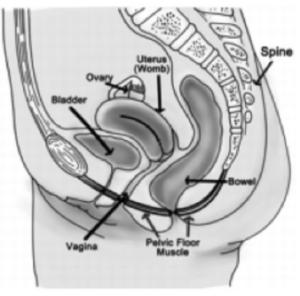Physiotherapy exercises
Day 0 onwards
Circulation – Help keep the blood moving in your legs by pumping your feet up and down from the ankles. Aim to do this each time you wake up or for 30 seconds each hour.
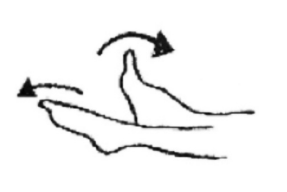
Deep breathing – This exercise should be performed every hour ideally when you are sitting upright and are well supported. Deep breathing can also help you to relax and relieve any nausea you may be experiencing.
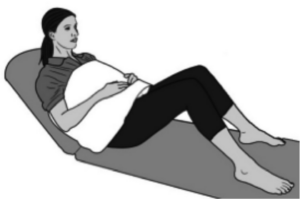
- Relax your shoulders and upper chest.
- Take a slow, deep breath in (through your nose, if possible) to fill your Lungs as fully as you can.
- Hold this breath for 3 seconds.
- Breathe out slowly through your mouth
Huffing: Take a deep breathe in, then breathe out quickly and forcefully through your mouth as if you were steaming up a window. This will help loosen any phlegm if needed.
Coughing: Be sure that you can cough strongly and effectively if needed after your operation to clear any excess secretions. Don’t worry your stitches and staples are very secure. You may find it
more comfortable to cough in the same position as for your deep breathing exercises.
Support your abdominal incision by holding a small towel or pillow firmly over your tummy. If your operation is through the vaginal route, place a hand over the pad between your legs.
Tips to help you get moving
Rolling in bed
If you are lying on your back it is best to bend your knees and support your tummy with your hand. Roll onto your side moving your shoulders at the same time as your hips and knees. Roll in
one movement to roll onto your back. This will avoid any straining and twisting.
Getting out of bed
Roll onto your side first. Lower your feet over the edge of the bed and push up with your arms. This will help you to sit on the edge of the bed without straining. Stand up slowly, trying to stand
straight and tall which will help you with your posture.
Getting into bed
With the back of your knees against the bed, use your hands to help lower yourself, so you are sitting on the edge of the bed. Using your elbow to lean on, lower yourself down onto your side,
at the same time lift your legs up onto the bed. Now roll onto your back supporting your tummy if you need to.
Standing up
We all look and feel better when we stand tall. This may be difficult to start with but should get easier as any level of discomfort decreases. Good posture will help prevent backache.
Sitting
Sitting back in your chair with a small pillow or rolled towel to support your lower back will help you to sit with a good posture.
Pelvic floor exercises
What and where are they?
The pelvic floor muscles are at the bottom of your pelvis. They attach to the pubic bone at the front to the coccyx (tail bone) at the back.
What does the pelvic floor do?
The muscles of the pelvic floor work like a hammock, to support the pelvic organs (bladder, womb & bowel). The pelvic floor muscles also help close the outlets from the bladder and bowel, keeping you clean and dry. The pelvic floor muscles need to be strong and getting these muscles working again after your operation is important to help with your recovery and prevent problems in the future. Start the exercises gently once your catheter has been removed and you have been able to pass urine on your own. If you have stitches underneath it is perfectly safe for you to do your pelvic floor exercises.
Your pelvic floor exercises can be performed in any position. To do the exercises, imagine that you are trying to stop yourself passing wind and urine at the same time. You can also think of squeezing tight in the vagina. You should feel your pelvic floor muscles ‘squeeze and lift’, try not to squeeze your buttocks and legs and breathe normally while you are doing these exercises.
You may feel a gentle tightening in your lower abdominal muscles which is normal. You need to practise both short squeezes and long squeezes and gradually build up your routine. As you do so
your muscles will get stronger and your exercise programme will gradually increase.
Short Squeezes
- Squeeze and lift your pelvic floor muscles and then relax
- Repeat until you feel that your muscles are tired
- Count how many times you can repeat your short squeezes
Long Squeezes
- Squeeze and lift your pelvic floor muscles and hold for several seconds, and then relax for several seconds.
- Count how long you can hold your muscles for.
- Repeat your long squeezes until you feel that your muscles are tired and count how many times you are able to repeat the exercise.
- Your pelvic floor muscle exercises should be performed at least three times a day. They can be performed in any position; you may find it easier to start off lying down or sitting. As your muscles improve aim to do some of your exercises standing up. It is very important to tighten your pelvic floor muscles before you do anything that may put them under pressure, such as lifting, coughing or sneezing.
Remembering to exercise
Make your pelvic floor exercises part of your daily routine; just like brushing your teeth, you should continue with these exercises for the rest of your life. Some tips to help you remember are:
- Use coloured reminder notes or stickers around the house or at work
- Do your exercises when you have finished emptying your bladder. Do not practise stopping the flow of urine mid-stream as this could affect your bladder function in the longer term.
- Use any advert breaks between television programmes
Abdominal exercises
It is important to exercise your abdominal muscles after any gynaecological operation. These muscles work to support your back and help with your posture. Using your abdominal muscles
when performing activities such as lifting or bending will make you feel more comfortable after having abdominal surgery. These exercises should be started within the first day or two after your
operation. As with the pelvic floor exercises, start gently and gradually build them up.
Day 2 onwards
Abdominal hollowing
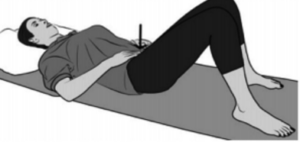
This exercise involves working the deep tummy muscles; it is a basic exercise which other exercises will build on. Whilst it may seem simple, it is important to practise to ensure that you are performing the exercises correctly.
Lie on your back with your knees bent, feet flat on the bed. Make sure your back is in a comfortable position, not too arched, not too flat. Keep your breathing relaxed throughout. Gently breathe in, to begin, and then as you breathe out gently draw the lower part of your tummy towards your spine.
Breathe normally, taking a few normal breaths whilst keeping these muscles drawn in. Relax your tummy muscles. Repeat this a few times. As you begin to feel more confident try holding for
longer, up to 10 seconds and repeat up to 10 times or try doing it sitting down and, later on, standing up.
Pelvic tilting
This exercise can help to reduce backache and relieve trapped wind after your operation. It also helps to gently work your abdominal muscles. Lie on your back with your knees bent, feet flat on the bed. Gently draw in your tummy muscles as above and tilt your pelvis to press your lower back into the bed. Hold this position for a few seconds, breathing normally, and gently relax. Repeat this a few times. If you do suffer from trapped wind after your operation, it will also help if you can get out of bed and walk around. The bowel may be slowed down temporarily but once it begins to work normally the trapped wind will ease.
Single bent knee fall out
Lie on your back with your knees bent, feet flat on the bed. Draw in your lower tummy muscles (as described in the abdominal hollowing exercise). Allow one knee to gently fall out to the side,
keeping your hips flat on the bed. Keep breathing normally. Return your knee to the starting position and then relax. Repeat to the other side. Try to do this a few times each side.
Knee rolling
Lie on your back with your knees bent, feet flat on the bed. Draw in your lower tummy muscles as before. Gently let your knees roll to one side, keeping your hips flat on the bed and keep
breathing normally.
Your knees should only move a short distance. Return your knees to the starting position and then relax. Repeat to the other side. Try to do this a few times each side.
Exercise progression
Gradually increase your exercises within a range of comfort. You can add to the repetitions and hold for longer as comfort allows. Walking is a good way to exercise. Start with a 10 minute walk
daily, increasing this to 30 to 40 minutes by the end of 6 weeks or two or three shorter walks if you prefer.
Going to the toilet
It is important to avoid constipation and straining. Straining puts pressure onto the pelvic floor and over time will weaken vaginal tissues. Ensure that you have a balanced diet and adequate
fluids. The following tips may be helpful in avoiding straining.
Ways to promote normal bowel habits
- Always go on first urge
- Drink 1.5-2 litres of fluids per day
- A diet high in soluble fibre is best examples fruits, vegetables, oat bran, barley, flaxseed, psyllium, lentils, soy milk/soy products
- Some fruit juices, pea, apples, warm orange juice and prunes are natural bowel stimulants and assist normal bowel function
- When going to toilet, use correct way to empty your bowel
Sit comfortably on the toilet with your legs slightly apart. Check that your knees are higher than your hips. A foot stool may help especially if your toilet seat is high. Rest your elbows on your
knees. Relax your jaw.
As you relax your pelvic floor to open your bowels relax your abdominal wall and make a gentle effort to widen your waist.
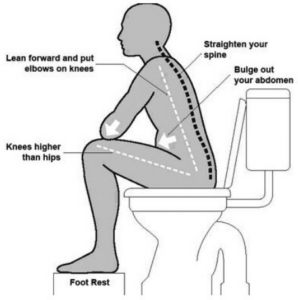
Advice for going home
Rest in the first 2 weeks
It is normal to feel tired and your body needs time to heal. Get plenty of rest 2 x short naps one mid-morning and afternoon and continue with the gentle exercises.
Walk short distances to begin with, gradually increasing the distance as you feel able.
Housework
No heavy lifting for 6 weeks to reduce the risk of a surgical hernia. After 2 weeks progress from light activities (dusting or washing up), gradually doing more until you are managing all your usual household activities by 6 weeks.
Sexual intercourse
To ensure there is good healing, you may want to wait for 6 weeks. A lubricant may reduce any initial discomfort
Back to work or sport
Within 6 – 12 weeks, depending on the surgery, your rate of recovery and the level of activity involved.
DO NOT (up to 6 weeks)
- Lift or push anything heavy until your tissues have had time to heal
- Strain when going to the toilet
- Drive until you can perform an emergency stop safely and please check with your insurance company who may have other clauses

